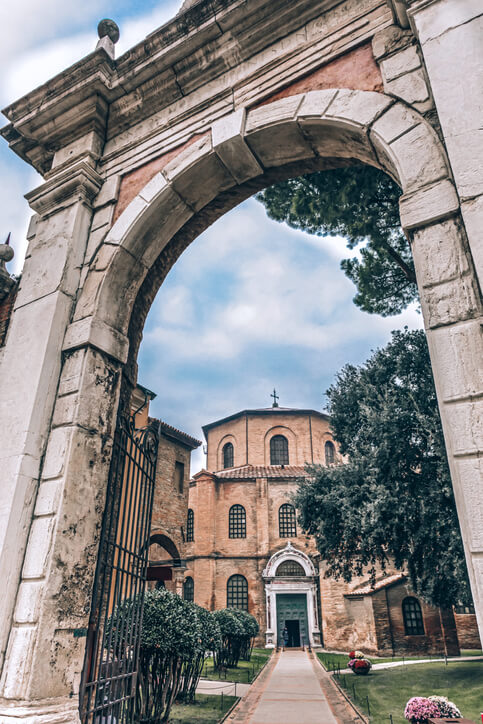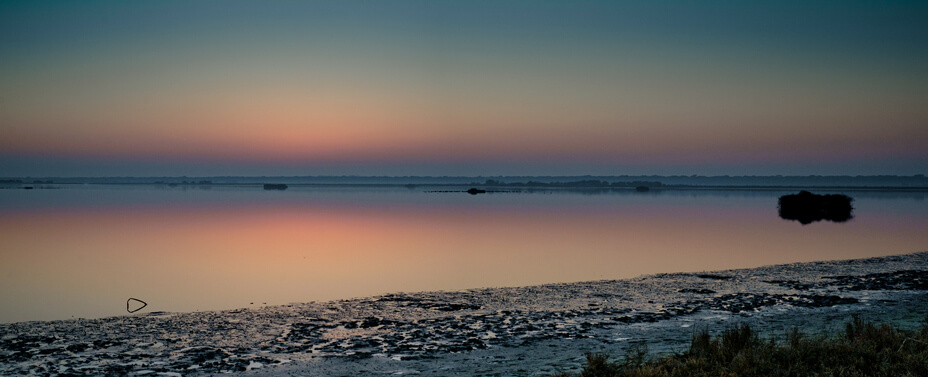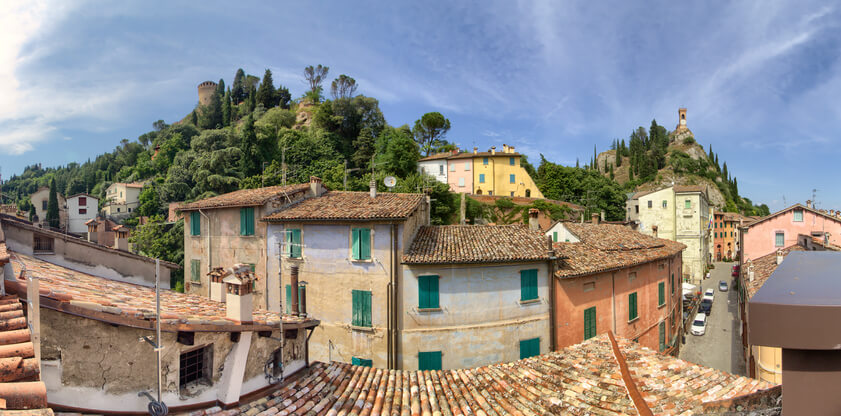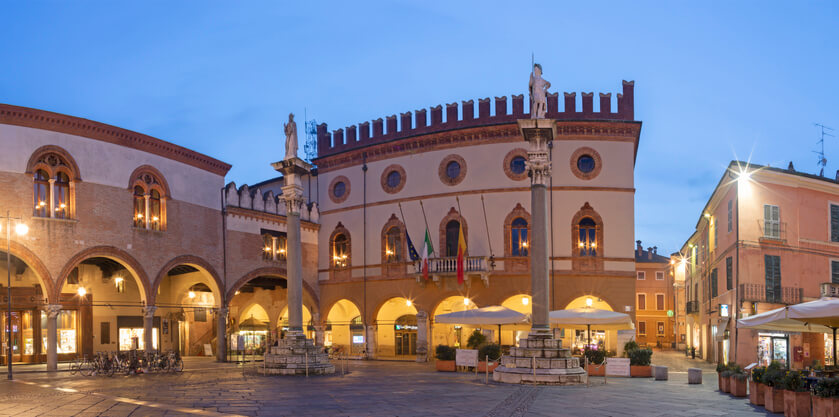Ravenna
Ravenna: The Glorious Past of the Mosaic City
Ravenna, a city with eight UNESCO heritage sites, and dubbed as the Mosaic City has endured a lot of major changes which drove the city into what it is right now. It holds a lot of significant happenings in the past that shaped not just Italy but across Europe. Even up to this day, the influence of these significant periods that took place in this city can still be observed and made a mark on the country’s culture and tradition. It was said that Italic people who moved southward from Aquileia about 1400 BC were the earliest inhabitants of Ravenna. It was then occupied by the Etruscans and later by the Gauls. It was in 191 BC that it came under Roman control and soon became important because it possessed one of the few good port sites on the northeastern coast of Italy. It was in AD 402 when the perils of barbarian invasions forced the Western Roman emperor Honorius to move his court from Rome to Ravenna. It was through this significant happening that led Ravenna to become the capital of the Western Roman Empire for 250 years. It was 476 when the fall of Western Empire unfortunately took place which made the city to be the capital of the first barbarian ruler of Italy, Odoacer (reigned 476–493). It was in 493 when the Ostrogothic king Theuderic entered the scene and made Ravenna the capital of the Ostrogothic kingdom, but it was then in 540 when it was occupied by the great Byzantine general Belisarius and made an imperial exarchate. With so many revolting circumstances that took place in the city, it was in 1859 when Ravenna made its union with the kingdom of Sardinia, which later became the kingdom of Italy in 1861. Currently, Ravenna is an agricultural and industrial city with its principal enterprises that span from petroleum to natural gas refining, to synthetic fertilizers and synthetic rubber productions and even in oil seeds’ processing. With several historical happenings in the city, it can never be denied that the influences of those events and periods are still reflecting and can still be observed in the city’s works of art which span from the architectures up to the culture and traditions.


Ravenna: More than just The City of Mosaics

One will be surprised to know that not much attention was paid to Ravenna, its origin is even unknown. It was speculated that it Ravenna came from the word “Rasenna”, which Etruscans used to call themselves as well. Etruscan is the one of the early civilizations of ancient Italy covering certain territories, we now know as Tuscany, western Umbria, northern Lazio, parts of Po Valley, southeastern Lombardy, southern Veneto and Campania.
The people of Ravenna may have been dated back from Villanovan period, this is somewhere between 9 th -8 th century BC. Society during this period were warrior-farmers living in small hut-villages, their control of mines of metal ores and their expertise in metals are pillars of this era.
Ravenna became accepted as part of the Republic in 89 BC., and gained historical importance as a city in 49 BC, from which Caesar went on to Cross the Rubicon in the drive for power that would ultimately make him dictator for life. It was Caesar’s great-nephew Octavian, Emperor Augustus Caesar from 27 BC-14 BC, who realized the significance of Ravenna to Roman control of the Adriatic Sea. He built a Roman fleet military harbor at nearby Classe, as patrol against pirates. Pirates during that time had become a major threat to Roman commerce in the Adriatic and the eastern Mediterranean seas.
Ravenna became the Roman gateway to Asia during the time in which Rome had conflict with Persia in the East. Rome at that time was ruled by Emperor Trajan (98–117 BC) built water channels to ensure freshwater supply for this strategic city.
In 402 BC, Western Italy Emperor Honorius moved the imperial capital was from Rome to Milan to because it was easily defended from its location on the lagoon. This decision was proved Honorius wisdom, as in 409 BC, King Alaric of the Visgoths marched to invade Rome but just passed by Ravenna.
The Roman Empire however was brought to its feet in 476 by the Odovacar of Heruli tribe, a German warlord. Eastern Italy Emperor Zeno, recognized the power that Odovacar holds. Italy was conquered by Theodoric – Odovacar’s nephew. Theodoric successfully carved out his own kingdom, with Ravenna at its center.
Italy was reclaimed including Ravenna in 535 by Eastern Italy Emperor then, Justinian I. Ravenna became the center of the restored Roman Empire in northern Italy, given its strategic location for military purposes and defense. The last known conquerors of Ravenna were the Lombards in 750. As of 2020, Ravenna city’s population is approximately 390,000.
Today, Ravenna is known as the capital of the Province of Ravenna, which is in Northern Italy. However, during the ancient times, particularly from 402 up to 476, Ravenna was chosen as the capital of the Western Roman Empire. Afterward, it became the capital of the Ostrogothic Kingdom. However, in 540, Ravenna was re-conquered by the Byzantine Empire. The Candiano Canal connects Ravenna to the Adriatic Sea. This city is popularly known for their ancient Roman and Byzantine architecture which are greatly preserved.
Ancient Period
- It is still uncertain what the origins of Ravenna are. But based on the oldest archaeological evidence, there was an Umbri presence from the 5th century BC until the 3rd century BC. when the Roman civilization started. The houses in Ravenna are constructed on piles in the small islands of a lagoon.
- Ravenna is the place where Julius Caesar assembled his forces in 49 BC before he moved to the Rubicon. Later, the military harbor of Classis, which was a significant station of the Roman Imperial Fleet, was discovered by Octavian.
- When Ravenna was ruled by the Romans, it became quite prosperous. At the start of the 2nd century, a 70 km long aqueduct was created by Emperor Trajan. In AD 402, the capital of the Western Roman Empire was changed by Emperor Honorius from Milan to Ravenna.
- Ravenna experienced a period of peace upon the return of Galla Placidia. During this time, the Christian religion was preferred, and the city has acquired some of the most popular monuments such as San Giovanni Evangelista, Mausoleum of Galla Placidia, and the Orthodox Baptistry.
- In the 5th century, Roman rule in the west disintegrated. Odoacer became the king of Italy and he ruled for 13 years. But in 489, he lost in the Battle of Verona and retreated to Ravenna. In 493, Ravenna was taken by Theodoric and was proclaimed as the capital of the Ostrogothic Kingdom of Italy. During this time, several magnificent buildings were constructed such as the Sant’Apollinare Nuovo and Theodoric’s own Mausoleum.
- Ravenna’s bishops built several churches from 540 to 600. Among the surviving monuments in Ravenna were the Basilica of Sant’Apollinare in Classe, the Basilica of San Vitale, and the San Michele in Africisco. In the 6th century, Ravenna was chosen as the seat of the Byzantine governor of Italy and was recognized as the Exarchate of Ravenna.
Middle Ages and The Modern Age
- In 712, Ravenna was conquered by the Lombards, however, it was regained back by the Byzantines. But the Lombard king, Aistulf, successfully conquered it again in 751, which marked the end of the Byzantine rule.
- When King Pepin of the Franks fought against the Lombards, Ravenna was taken by the 1Popes. From 1218 to 1240, the city was ruled by the Traversari family. In 1248, Ravenna was regained by the Papal States. But the Traversari took it again and ruled until 1275. During this time, one of the most artistic individuals of Ravenna was the famous poet Dante who has been exiled.
- Venice ruled Ravenna until 1509. During the Renaissance, Ravenna was recognized as the birthplace of the Monster of Ravenna. In May 1636, the city was destroyed by a large flood. However, during the succeeding 300 years, the possibility of flooding has been reduced through the series of canals.
- Ravenna became a part of the Papal States until 1796. In 1859, the Piedmontese troops occupied the city. In 1861, Ravenna as well as the Romagna area were managed by the new unified Kingdom of Italy.
Top Attractions
- Neonian Baptistery
- One of the oldest buildings in Ravenna and is considered to be the finest example of Christian Baptistery still surviving. Complex mosaics line its entire dome, culminating in a large mosaic medallion at the top picturing the Baptism of Christ by John the Baptist
- San Vitale
- Built in the first half of the 6th century, and behold one of the most important examples of early Christian Byzantine art and architecture in Western Europe. The mosaic in the choir portray Justinian, his wife Theordora and their court, Christ, St. Vitalis and St. Ecclesius.
- Mausoleum of Galla Placidia
- Made in honor of Emperor Honorius’ sister, Galla Placidia. Inside are marble tombs, which are thought to be of Galla Placidia, her husband and son, all of whom died in the fifth century. The UNESCO citation calls this «the earliest and best preserved of all mosaic monuments, and at the same time one of the most artistically perfect.»
- Sant’Apollinare Nuovo
- A basilica built by Theodoric in the 6 th century to be his cathedral.
- Basilica di San Francesco
- Located halfway between the Neonian Baptistery and Sant’Apollinare Nuovo and built in the 10 th century, is a Franciscan church which in its churchyard has the large tomb of Dante, a great Italian writer who was the first to promote the use of one Italian language. Some of the columns of this great church were carved by Tullio Lombardo and Pietro da Rimini.
- Museo Nazionale
- A handicap-accessible museum houses several treasures of history including the original drawing of the mosaic of Sant’Apollinare in Classe. Inside is also a cycle of 14th-century murals of Santa Chiara, a masterpiece by Pietro da Rimini, preserved from the convent church of the Poor Clares in Ravenna.
- Arcivescovado (Archbishop’s Palace)
- Cited by UNESCO as the smallest among the Ravenna attractions, built in the 6th century shaped after a Greek cross. Also inside is a small museum that holds a sixth- century Egyptian throne with reliefs of carved ivory.
- Tomb of Theodoric
- Ravenna’s only UNESCO cited attraction without a single tessera, which means no stone, tile, or glass were used to build it. Theodoric planned this for himself.
- San Giovanni Evangelista
- A church founded by Galla Placidia in 424, with mosaics depicting mythical animals, medieval stories, and historical scenes. The church suffered during the bombings of the Second World War, and much of it were destroyed but were rebuilt to its original form conserving its many original features.
- Mirabilandia
- On a more modern note, this is Italy’s largest amusement park covering 850,000 square meters of land. Some of the main attractions are – Eurowheel, the 2 nd largest ferris wheel in all of Europe measuring 90 meters high. Katun, an inverted roller coaster and Mirabilandia Beach, the world’s tallest water coaster at 60 meter high.

Ravenna’s heritage is a mixture of spirituality and classical art along with the splendid array of mausoleums, baptisteries, and basilicas. When it comes to Ravenna’s mosaics, Dante believes that they are the delightful color of Oriental sapphires.
These mosaics brightened up the Scriptures through the iconic images. They signify man’s absolute striving for the supreme. Most probably, the early mosaics were created by the Greek artists from Constantinople. These dramatic mosaics were a great influence on some artists. For instance, the Austrian artist Gustav Klimt was inspired by the mosaics of Sant’Apollinare Nuovo. When Cole Porter was writing the song “Night and Day”, he was inspired by the gold star and blue sky from the mosaics in Mausoleum di Galla Placidia.
Museums and Libraries
- Most of the museums and libraries in Ravenna are found inside the extensive and ancient monasteries. These were originally part of the convent and constructed near the churches of the city. Nowadays, museums and libraries are the center of cultural activities as well as the keepers of valuable memories. Historical and artistic heritages with extensive values are well preserved here.
- Ravenna has a lot of splendid museums. Inside the MAR Ravenna Art Museum, you can find a lot of permanent magnificent collections and temporary renowned exhibitions. Here, you will be able to admire the contemporary mosaic collections. Within the city center, you can visit the National Museum of Ravenna where you will be able to witness the frescoes of Santa Chiara as well as the artifacts of Byzantine and Roman periods. The Archepiscopal Museum is where you can find the ivory pulpit of Massimiano and other collections. The Tamo Museum provides an actual tour inside the world of mosaic.
- At the new museum Classis Ravenna, which can be found within the Archaeological Park of Classe, you will be amazed by the current archaeological finds, especially if you are an archaeological enthusiast. Now, it is considered as one of the most significant archaeological museums in Italy. Here, you can travel back in time and experience the history of Ravenna.
- Other museums that are worth visiting include the Dante Museum, the historic Museums of Marionette and of Dolls, and the Risorgimento Museum.
Facts
- Ravenna is in the region of Emilia-Romagna in Italy and is considered as one of the largest places in Italy. Its population is approximately 80,868.
- Ravenna has several tourist attractions. The best place to start is the Piazza del Popolo, where lovely historic buildings can be found such as the Palazzo Comunale which was constructed in the fifteenth century. In the square, you can find two columns with the statues of Sant’Apollinare and San Vitale.
- Ravenna is popularly known for its splendid early Christian and Byzantine mosaics. In fact, its greatest mosaics were included in the listing of UNESCO’s World Heritage. These mosaics are mostly found in churches.
- The Basilica di San Vitale is filled with mosaics, particularly Byzantine mosaics which depict the Old Testament. This church was constructed between 526 and 547 and is considered as the glory of Ravenna.
- The Mausoleum of Galla Placidia is dedicated to Galla Placidia, who was the daughter of a Roman Emperor. Some people believed that it was used as her tomb, however, her body was never found here. The walls are rich in pictorial mosaics.
- Mosaics can also be found in the Battistero Neoniano, Cappella Arcivescovile, Basilica di Sant’Apollinare Nuovo, Battistero degli Ariani, Cappella Arcivescovile, and many more.

- The Ravenna Music Festival
- The Ravenna Music Festival which has been running for more than 20 years showcases genres of classical, jazz, and world music which is highly exceptional and quite experimental as they are performed in varieties of venues in Ravenna but mostly highlights the city’s marvelous architectures. The festival runs for two months from May to July each year.
- Alighieri and Rasi Theaters
- Mosaico di Notte
- Mosaics by night is usually held Monday-Friday from June to September. If you have been mesmerized by the mosaics’ beauty during the day, then be ready to be fully captivated by its beauty at night glistened by night lights.
- Antiques Market
- Mausoleum of Galla Placidia
- Neonian Baptistery
- Basilica of Sant’Apollinare Nuovo
- Arian Baptistery
- Archiepiscopal Chapel
- Mausoleum of Theodoric
- Church of San Vitale
- Basilica of Sant’Apollinare in Classe
- Domus dei Tappeti di Pietra
- Museo Nazionale (National Museum)
- Tomb of Dante Alighieri
- Mirabilandia
Things to do in Ravenna
- Take a dip in Ravenna’s Seaside
- If you are a thalassophile, Ravenna would surely take a place in your heart. There are nine seaside resorts on the coast of Ravenna which are just waiting for you to explore. What’s more exciting is that the beaches come to life every night. So, if you are fond of night life, this is really a must for you.
- Biking through the Pine tree forest
- Biking is one of the creams of the crop in every Italian travel destination activity. Here in Ravenna, you can book bike tours. What makes it more unique is cycling through the pine forests. Imagine the therapeutic and relaxing effects it would give to you while enjoying the scenic spots along the way.
- Aperitif (Italian Way of Happy Hour)
- Though somehow similar to American Happy Hour, aperitif is much more than that. It is a pre-meal drink usually meant to stimulate your appetite right before dinner. Sip into local cocktails and indulge yourself in a variety of delicious finger food.
- Visit Mosaic Studio/School
- Ravenna being known as the City of Mosaic, it is really recommended to visit studios or schools that offer mosaic workshops for you to truly understand and appreciate the process in making these striking masterpieces.
- Basilica Sight-seeing
- There are several amounts of historical and religious site in Ravenna while religious architectures might not be everyone’s cup of tea, magnificent basilicas in Ravenna might convince you otherwise to take as stroll and witness the details of intricate arts spent in putting up these marvelous architectures.

